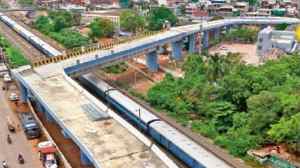My patient’s blood sugar level went up after meals: Rice/roti or salads, veggies first?
How shuffling food leads to better blood sugar regulation
 When carbohydrates are eaten first, especially refined ones like white rice or breads, they quickly break down into sugar, causing a sharp rise in blood glucose. (File Photo/Canva)
When carbohydrates are eaten first, especially refined ones like white rice or breads, they quickly break down into sugar, causing a sharp rise in blood glucose. (File Photo/Canva)One of my patients was troubled by his post-meal readings. “I now eat on time, have a healthy thali of home-cooked food — sabzi (vegetables), dal, salad, a small portion of rice or roti. But my post-meal reading came to 210 mg/dL, when it should not be more than 140 mg/dL. The reading after two hours of eating a meal came to 280 mg/dL, which should be less than 180 mg/dL. What am I doing wrong?” he asked me.
Despite a balanced Indian thali every day, he was still experiencing post-meal fatigue, sugar spikes or cravings. The issue was not what he was eating but how he was eating it. So we reversed the order of what he ate first. We made him have salads and vegetables first, both of which are fibre-rich. Then we followed it up with dal, soybean or protein, which added further heft to the meal. In the end we followed up a remnant of all these with rice or roti. By then he was quite full and had very little of the carbs. His blood sugar levels gradually went down to normal by simply shuffling his food around.
Why food sequence matters
Our bodies process different nutrients at different rates. When carbohydrates are eaten first, especially refined ones like white rice or breads, they quickly break down into sugar, causing a sharp rise in blood glucose. This can trigger insulin surges and a subsequent drop in energy. However, when fibre and protein are eaten first, they slow the digestion and absorption of sugars that follow.
The Ideal Eating Order
For better blood sugar regulation, follow this simple sequence.
Fibre first: Begin your meal with a portion of salad, sautéed vegetables or lightly cooked greens. The soluble fibre in these foods helps form a gel-like barrier in the stomach, delaying the absorption of sugars from subsequent foods.
Protein and healthy fats next: This includes dal, curd, paneer, tofu, eggs, or lean meat. Proteins and fats further slow gastric emptying and promote satiety, which can help reduce the total quantity of food consumed.
Carbohydrates last: End your meal with rice, roti, or other grains. Eating carbs at the end allows your body to digest them more slowly, leading to a lower glucose response post-meal.
A Note on Dal: Protein or Carb?
Dal is often celebrated for being rich in plant-based protein. However, it’s important to note that dals also contain a significant amount of carbohydrates. While they are a nutrient-dense option, their carb content should be accounted for in the total calories allowed per day — especially when paired with other carbohydrate-rich foods like rice or chapati.
Researchers in Japan tested participants with the same meal, which consisted of protein, vegetables and white rice. When participants began by eating a simple carbohydrate — in this case, white rice — their post-meal blood glucose and insulin levels were measurably higher than those who had eaten the white rice last. Conversely, when those same participants began by eating protein and vegetables and saved the rice for last, their post-meal insulin and glucose levels were measurably lower.
Include probiotic-rich foods like yoghurt or buttermilk. Probiotics can help improve gut health and potentially reduce blood sugar spikes.
(Dr Bhattacharya is endocrinologist, Indraprastha Apollo Hospitals, New Delhi)
Photos




- 01
- 02
- 03
- 04
- 05



























